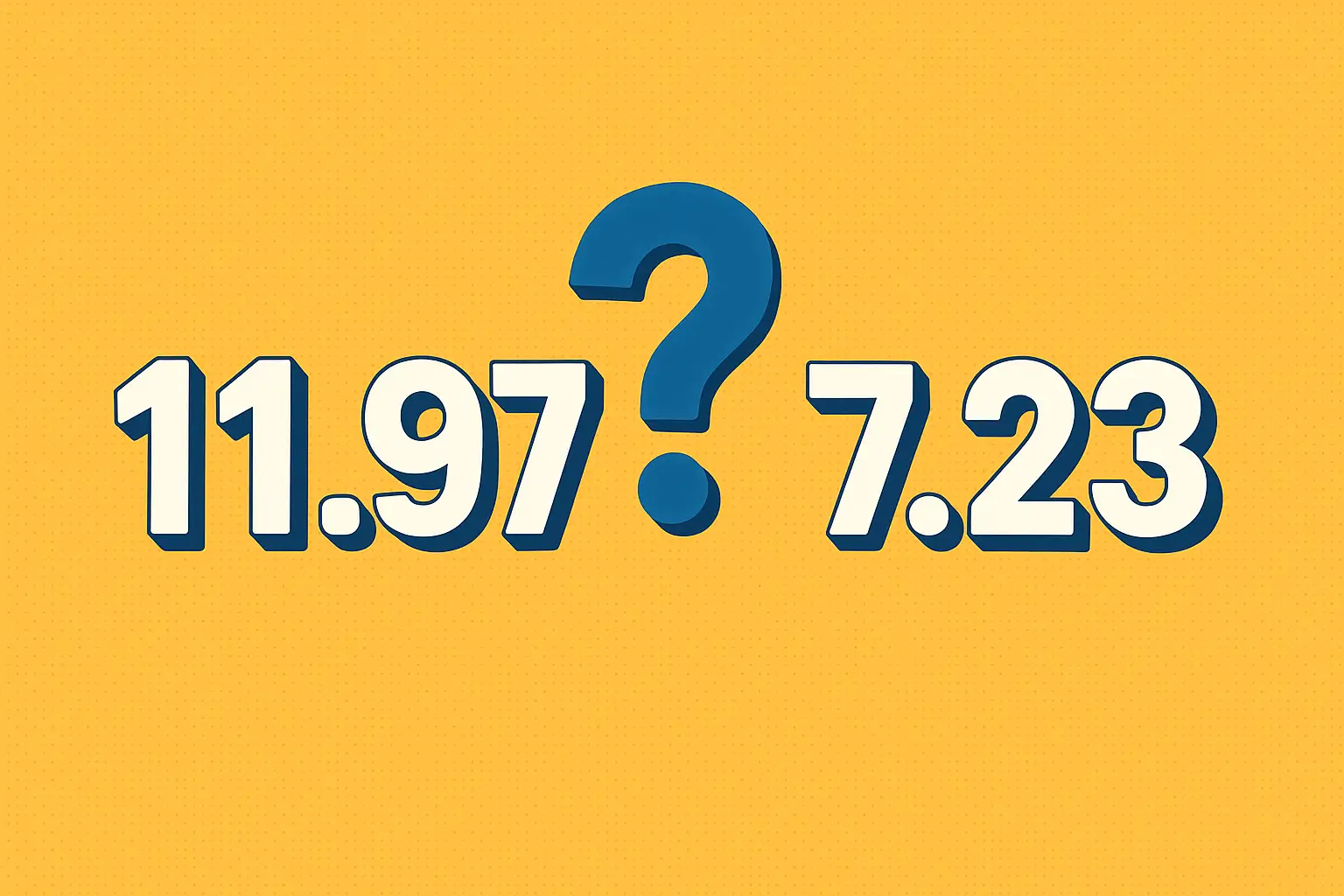Have you ever looked at two numbers and wondered what sets them apart? Today, we’re diving into the intriguing comparison between 11.97 and 7.23.
On the surface, they might seem like ordinary digits, but there’s more to them than meets the eye. As you read further, you’ll uncover fascinating insights into how these numbers differ and what they mean for you. Whether you’re making a decision or just curious, understanding these numbers could hold the key to clearer choices and smarter strategies.
Stick around, because the answers you seek could transform the way you view numbers and their impact on your life.
Numerical Difference
11. 97 minus 7. 23 equals 4 74. This shows the numerical difference between the two values. Understanding this helps in basic math calculations.
Understanding the numerical difference between two numbers can be quite simple, yet it’s a fundamental concept that plays a crucial role in everyday life. Whether you’re managing your finances or keeping track of scores, knowing how to calculate differences can help you make informed decisions. Let’s break down the difference between 11.97 and 7.23 and see what insights this can offer.
1. What Is A Numerical Difference?
A numerical difference is the result you get when you subtract one number from another. This value tells you how far apart these numbers are. In our case, you subtract 7.23 from 11.97.
2. Calculation Of The Difference
To find out the difference, perform a simple subtraction:
11.97 – 7.23 = 4.74
Here, 4.74 is the numerical difference. It signifies how much greater 11.97 is than 7.23.
3. Practical Implications
Think about planning a budget. If an item costs $11.97 and you have $7.23, you’re short by $4.74. Knowing this helps you make better purchasing decisions.
4. Real-life Example
Consider a situation where you need to travel a distance of 11.97 miles, but you only have enough fuel for 7.23 miles. Knowing the difference alerts you to the need for more fuel.
5. Why Does This Matter?
Understanding differences helps you assess gaps, whether in measurements, finances, or time. How often do you find yourself guessing instead of calculating?
6. Encouraging Accurate Calculations
Accuracy matters. Mistakes can lead to overspending or running out of resources. Always double-check your calculations to avoid costly errors.
7. Encouraging Thought
Have you ever underestimated a difference and faced unexpected consequences? This simple calculation can save you from potential surprises.
By understanding the numerical difference, you gain a tool that aids in planning and decision-making, ultimately leading to more efficient outcomes.
Mathematical Operations
Mathematical operations are the backbone of everyday calculations, whether you’re budgeting for groceries or measuring ingredients for a recipe. Understanding simple operations like addition and subtraction can make a significant difference in your daily tasks. Let’s dive into the subtraction process and explore why addition is relevant when comparing numbers like 11.97 and 7.23.
Subtraction Process
Subtracting two numbers is a straightforward process. You take the larger number and remove the smaller one. With 11.97 and 7.23, you begin by subtracting 7.23 from 11.97.
Here’s a quick breakdown:
- 11.97 – 7.23 = 4.74
The result, 4.74, is what remains after removing the smaller number from the larger one. Try visualizing this subtraction as removing 7.23 units from a total of 11.97 units. Have you ever experienced the satisfaction of solving a puzzle? That’s the kind of clarity subtraction provides.
Addition Relevance
While subtraction helps find the difference, addition ensures understanding of how the numbers relate to one another. By adding 7.23 to 4.74, you can verify your subtraction process.
Consider this:
- 4.74 + 7.23 = 11.97
It confirms the original total. Addition isn’t just verifying subtraction; it helps you understand how parts make up a whole. Have you ever pieced together a jigsaw puzzle? Each piece has its place, just as each number contributes to the final sum.
Why does this matter to you? Imagine organizing a budget or planning a meal. Recognizing how numbers fit together can streamline your efforts and improve accuracy. Are you ready to see how numbers can transform your daily activities?
Decimal Places
Understanding decimal places helps compare numbers like 11. 97 and 7. 23. The first number is larger by 4. 74. Decimal points separate whole numbers from fractions, allowing precise calculations.
Understanding decimal places is crucial for anyone working with numbers. Whether you’re balancing your budget, calculating recipes, or managing spreadsheets, decimal places matter. They determine how precise your numbers are, affecting accuracy and outcomes.
Importance Of Precision
Precision is key when dealing with decimal numbers. Have you ever tried baking a cake and added just a bit too much or too little of an ingredient? Small differences can lead to big changes. The same goes for decimal places.
When you compare 11.97 and 7.23, the two numbers might seem close. However, when accuracy is essential, such as in financial calculations, this difference is significant. Imagine if every cent mattered in your bank account. You’d want those figures exact, wouldn’t you?
Role In Calculations
Decimal places play a pivotal role in calculations. Let’s say you’re splitting a bill with friends. A difference between 11.97 and 7.23 affects how much each person pays. It’s not just about cents; it’s about fairness and accuracy.
Consider how these numbers impact larger calculations. In engineering, a slight error due to decimal imprecision can lead to faulty structures. When precision is non-negotiable, understanding decimal places becomes vital.
Have you ever double-checked a calculation only to find a small error in decimal placement? That tiny detail can change outcomes. It shows why keeping an eye on decimal places is a smart habit.
By recognizing the significance of decimal places, you ensure accuracy in everyday tasks. You become more effective in managing your numbers, whether for personal or professional use. How might your approach to decimals change now?

Real-world Applications
Understanding the difference between 11. 97 and 7. 23 is crucial in real-world scenarios. Whether in budgeting or measurements, knowing these numbers helps make accurate calculations. This difference impacts decisions in finance, engineering, and daily life.
Understanding the difference between two numbers, such as 11.97 and 7.23, might seem like a simple math problem. However, these figures hold significant meaning in various real-world applications. Whether you’re managing finances or conducting scientific experiments, this numerical difference can have a substantial impact.
Financial Transactions
In finance, even a small difference in numbers can mean the world. Imagine you’re comparing two monthly expenses: $11.97 for a subscription and $7.23 for another. It might seem minor, but over a year, that difference adds up to nearly $57.
Consider how this affects your budgeting. Could you use that extra cash for something more important? Perhaps reinvest it or save for a rainy day?
These decisions are crucial in managing personal finances. Every cent counts, and understanding such differences helps you make informed decisions.
Scientific Measurements
In scientific measurements, precision is key. A difference between 11.97 grams and 7.23 grams can be critical in a chemical experiment.
This seemingly small numerical gap can determine whether a reaction is successful or not. In my college chemistry class, a slight miscalculation similar to this led to a failed experiment.
Such experiences teach us the importance of accuracy. In scientific research, every decimal can change the results, impacting conclusions and further research.
When you consider these applications, how often do you overlook small differences in numbers? Are there areas in your life where paying closer attention could lead to better outcomes?
Understanding these differences is essential in both finance and science. It helps you make smarter decisions and achieve more accurate results.
Common Misunderstandings
Numbers can sometimes confuse people. Especially when comparing decimals. The difference between 11.97 and 7.23 is simple. Yet, many misunderstand it.
This section aims to clear common misconceptions. Let’s explore how these numbers differ and why it matters.
Misunderstanding: Decimal Complexity
Decimals look complex at first. People often think they need advanced math to understand them. But it’s simple subtraction.
Subtract 7.23 from 11.97. The answer is 4.74. Basic math skills are enough.
Misunderstanding: Size Matters
Some think larger numbers are always better. But that’s not true. Each number has its purpose. 11.97 might seem better due to size. Yet, 7.23 could be more relevant in context.
Misunderstanding: Decimal Place Significance
Many believe more decimal places mean more value. This is a misconception. The number of decimal places does not always affect value.
Precision is key, but not always significant. Understand the context to use decimals wisely.
Misunderstanding: Comparing Apples To Oranges
People often compare numbers without context. Numbers need context to make sense. Comparing 11.97 to 7.23 needs a reason. Is it for weight? Price? Understanding context helps avoid errors.
Practical Examples
Understanding the difference between 11. 97 and 7. 23 involves simple subtraction. The result is 4. 74. This difference can represent anything, such as money, distance, or scores. Knowing how to calculate such differences is useful in everyday situations.
Understanding the difference between numbers can sometimes be more than a mere mathematical exercise. It can be a gateway to real-world applications and insights that can impact your daily life. In this section, we’ll explore practical examples of the difference between 11.97 and 7.23. By the end, you’ll see how these numbers can play out in various scenarios, perhaps even in ways you hadn’t considered before.
Understanding The Difference: A Simple Subtraction
The difference between 11.97 and 7.23 is 4.74. This number might seem small, but its implications can be significant in certain contexts. Think about a budgeting scenario. If you save $4.74 every day, you’d save over $140 in a month. Imagine what you could do with an extra $140!
Grocery Shopping And Budgeting
Consider grocery shopping. You have two options: one item costs $11.97, and a similar item costs $7.23. The difference is $4.74. If you consistently choose the cheaper option, you could save a considerable amount over time. This approach can help you manage your grocery budget more effectively.
Monthly Subscription Services
Many subscription services offer different plans. One might be priced at $11.97, and another at $7.23. The difference of $4.74 per month translates to saving $56.88 annually. Is the higher-priced plan worth that extra cost? Evaluate the features and decide what matters more to you.
Fuel Efficiency And Transportation
Think about fuel prices. If one station offers gas at $11.97 per gallon and another at $7.23, choosing the cheaper option saves $4.74 per gallon. If you fill a 15-gallon tank, that’s a savings of $71.10. Over time, these savings add up, allowing you to allocate funds elsewhere.
Investment And Interest Rates
In investments, the difference between a 11.97% return and a 7.23% return is significant. Over time, that 4.74% difference can grow your investment substantially. Think about long-term goals like retirement or buying a house. How could a better return impact your financial future?
Each of these examples highlights how understanding the difference between 11.97 and 7.23 can lead to smarter financial decisions. What other areas in your life could benefit from this insight?

Frequently Asked Questions
What Is The Numerical Difference Between 11.97 And 7.23?
The numerical difference between 11. 97 and 7. 23 is 4. 74. This is calculated by subtracting 7. 23 from 11. 97. Understanding this helps in various mathematical and real-world applications.
How Do You Calculate The Difference Between Two Numbers?
To calculate the difference, subtract the smaller number from the larger one. For example, 11. 97 minus 7. 23 equals 4. 74. This simple arithmetic operation is essential in both basic and complex calculations.
Why Is The Difference Between Numbers Important?
Understanding the difference helps in comparing values effectively. It assists in financial calculations, measurement adjustments, and statistical analysis. Knowing the difference provides clarity in data interpretation and decision-making.
How Does The Difference Affect Mathematical Operations?
The difference between numbers influences calculations, such as finding averages or creating equations. It helps in understanding relationships between values, essential for problem-solving and data analysis.
Conclusion
Understanding the difference between 11. 97 and 7. 23 is crucial. It can impact your decisions in various contexts. Whether dealing with math or finance, these numbers hold significance. They aren’t just digits; they represent values that affect outcomes. Being aware of the distinction helps in precise calculations.
It ensures accuracy and avoids potential errors. This knowledge can enhance your problem-solving skills. Always double-check your figures to confirm accuracy. By grasping these differences, you make informed choices. This leads to better results in daily tasks. Stay informed, stay accurate, and make smart decisions every time.

I’m someone who’s always been fascinated by how small differences can lead to big understanding. That’s why I love writing “What’s the difference between…” content; it helps me explore topics from multiple angles and explain them in a clear, practical way. Whether it’s tech, productivity, business, or everyday decisions, I enjoy making complex ideas easier to compare, understand, and act on.








